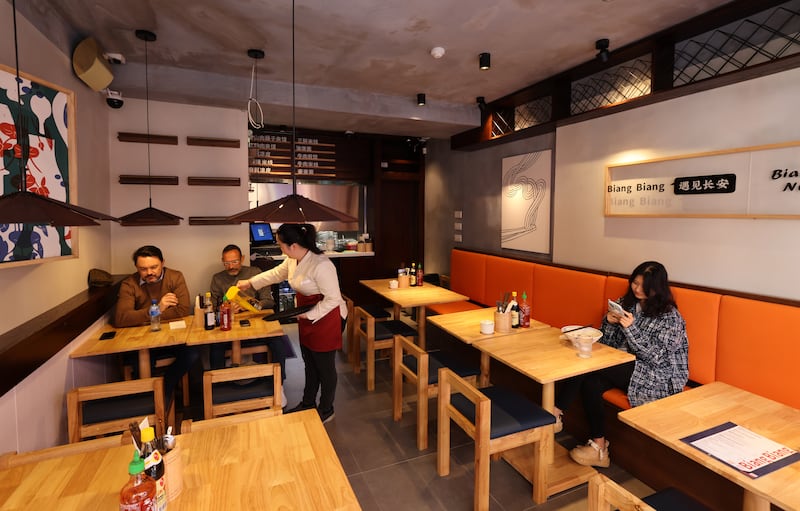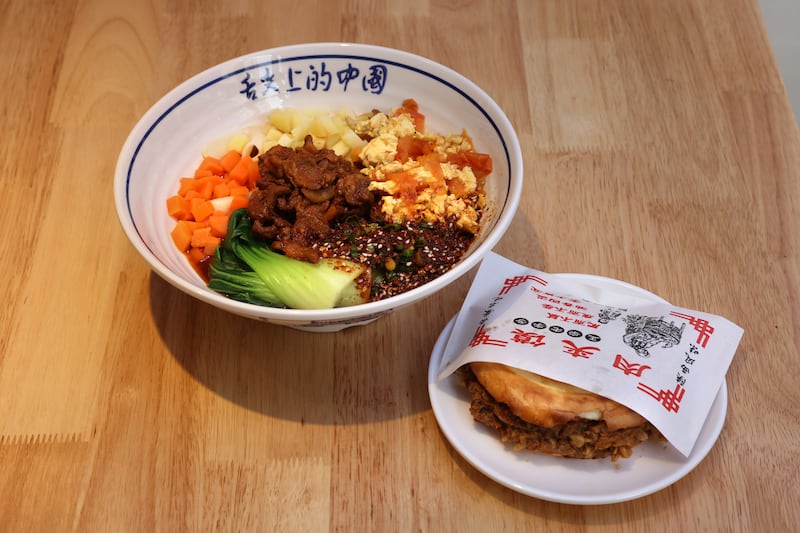In 1664, the Dublin City Assembly voted to divide Oxmantown Green into 96 portions, while also allocating space for a new road and a large market. The area became known as Smithfield, probably after the place that hosted a similar market in London. The market itself, on Mary’s Lane, is sometimes referred to as Smithfield Market, although its official name has always been the Dublin Fruit and Vegetable Market. The current building dates to 1892, and stopped trading as a market in 2019, although thankfully there are now plans to renovate and reopen it.
Just a stone’s throw away is Biang Biang on Little Mary Street, a restaurant that specialises in handmade noodles from X’ian in the northerly Shaanxi province of China. It’s a small room with 12 tables; smart in a functional sort of way. It’s walk-in only. We arrive just before 6pm and are lucky to land a table.
I don’t often comment on service because I expect it to be good, but I have to say that our waiter is one of the loveliest I have encountered in a long time. He explains how our dumplings will take a bit of time, as they are made to order – we can have them in chilli oil or hot and sour soup (we go for the latter) – and he keeps our glasses filled with water throughout our short stay, which is less than an hour. When he’s not busy looking after everyone in the room, he shines glasses with the delicacy of a craftsman.
The menu is short. The dumplings are a speciality that have been well established by the owners of this restaurant, who are also the people behind Bullet Duck and Dumpling, a few doors down on Little Mary Street, as well as Little Dumpling, Nan and Hakkahan scattered around the city. The dishes that are new to their repertoire here are roujiamo, Chinese hamburgers (also from the Shaanxi province); liang pi, which are perhaps lost in translation when they’re described as cold skin noodles; and biang biang, the hand-pulled noodles with a name that is said to reflect the sound the noodles make as they are smacked down on to the counter to stretch them into impressively long belts.
Rolls takeaway review: Pop-up in Howth serving lobster rolls by the water’s edge
Floritz review: A glitzy but perplexing new restaurant with an overwhelming menu
Green Bench Cafe takeaway review: Top-tier sandwiches in a most delightful city centre spot
September, Blackrock, review: We need more walk-in restaurants in scenic spots like this - absolutely delightful
Our beer arrives, two bottles of Tsing Tao (€5.50 each). On the table, there is sriracha, Chinkiang vinegar, chilli oil, wooden chopsticks, forks, spoons and napkins, so we are well set up when our first dish arrives.
Liang pi (€9) is a noodle dish that can be made from rice or wheat, depending on the region. Here it is made from a wheat dough which is rinsed in water, and the water, which is essentially the starch, is allowed to settle into a slurry. The excess water is removed from the bowl, and the paste is spooned on to a pan and steamed. The steamed dough is then cut into strips, making noodles. They are chewy, nutty and utterly delicious in a garlic, chilli oil and black vinegar dressing with slivers of cucumber, beansprouts and sesame seeds.
Our vegetable dumplings (€9), arrive in hot and sour soup, topped with chillies, sesame seeds and coriander leaf, which adds an aromatic dimension.
Above the chatter and music, we can hear our biang biang noodles (€12.50) being made in the kitchen and see the action through the narrow hatch. According to Fuchsia Dunlop, who has written widely on Chinese food, one of the reasons that biang biang noodles are renowned is because their name is based on the most complicated of all Chinese characters. It is not one of the characters on the sign over the door at Biang Biang, which I discover mean “meet Chang’an”, Chang’an being the ancient name of today’s Xi’an.


The noodles are enormous, I haven’t a hope of slurping them in one go, and worse still, I end up swapping my chopsticks for a fork. They are elastic and irregularly shaped, just chewy enough to display the revered texture known in East Asia as Q. With Bok choi, carrots, spring onions and slices of star anise scented Andarl pork, they are topped with sauces and chilli oil.
Biang Biang gives a real sense of what this neighbourhood could be. When the market reopens, it would be wonderful to see more restaurants that reflect the community in the area, which could source their vegetables from the market to bring us a taste of many homes. With a little bit of thought and investment, it could happen.
Dinner for two with beers was €41.50.
The verdict: A wonderful Chinese restaurant in a historic part of the city.
Food provenance: FX Buckley, Silverhill Duck, Manor Farm free-range chicken, Asia Market, Caterworld and Sysco.
Vegetarian options: Vegetarian dumplings and biang biang noodles with tomato, egg, aubergines and beans.
Wheelchair access: Accessible with no accessible toilet.
Music: Pop, with Bones & The Boy and Darnel Neel.





